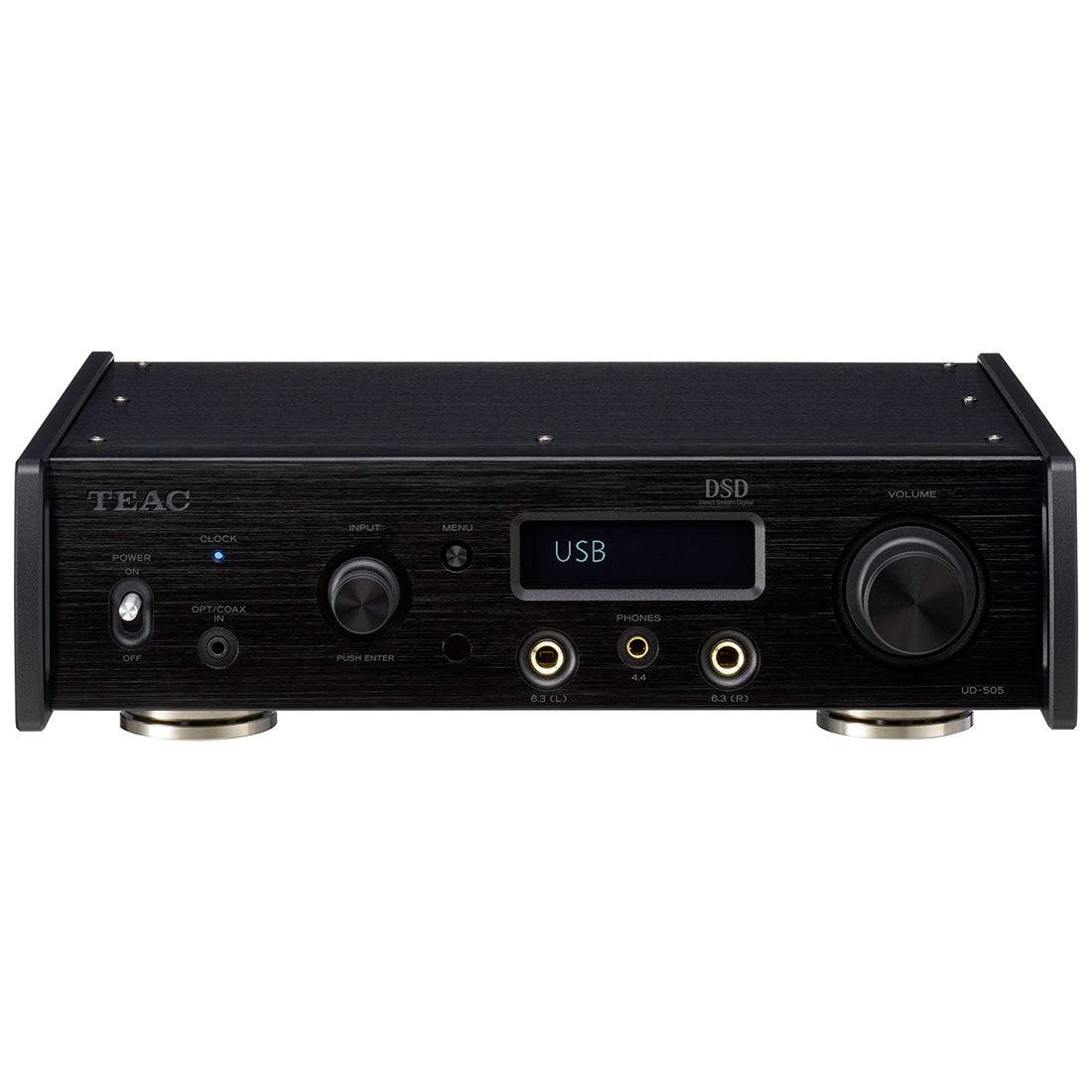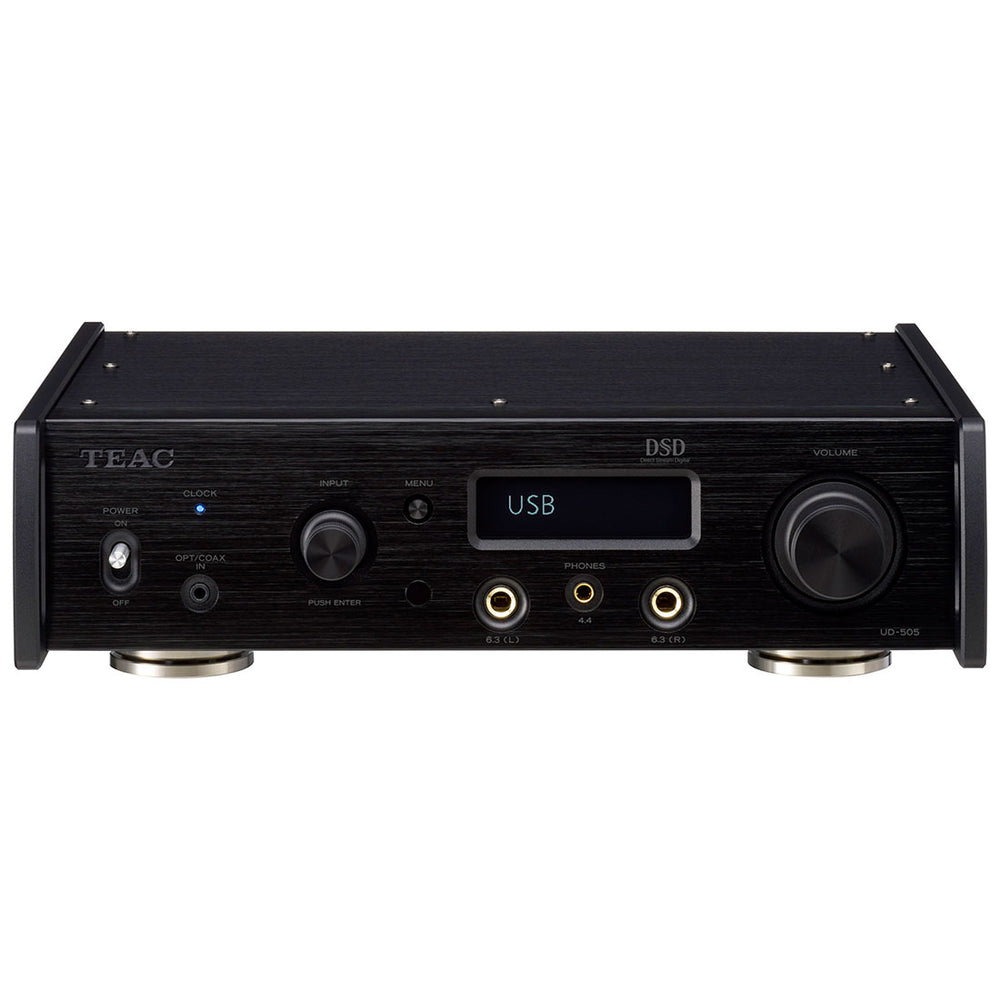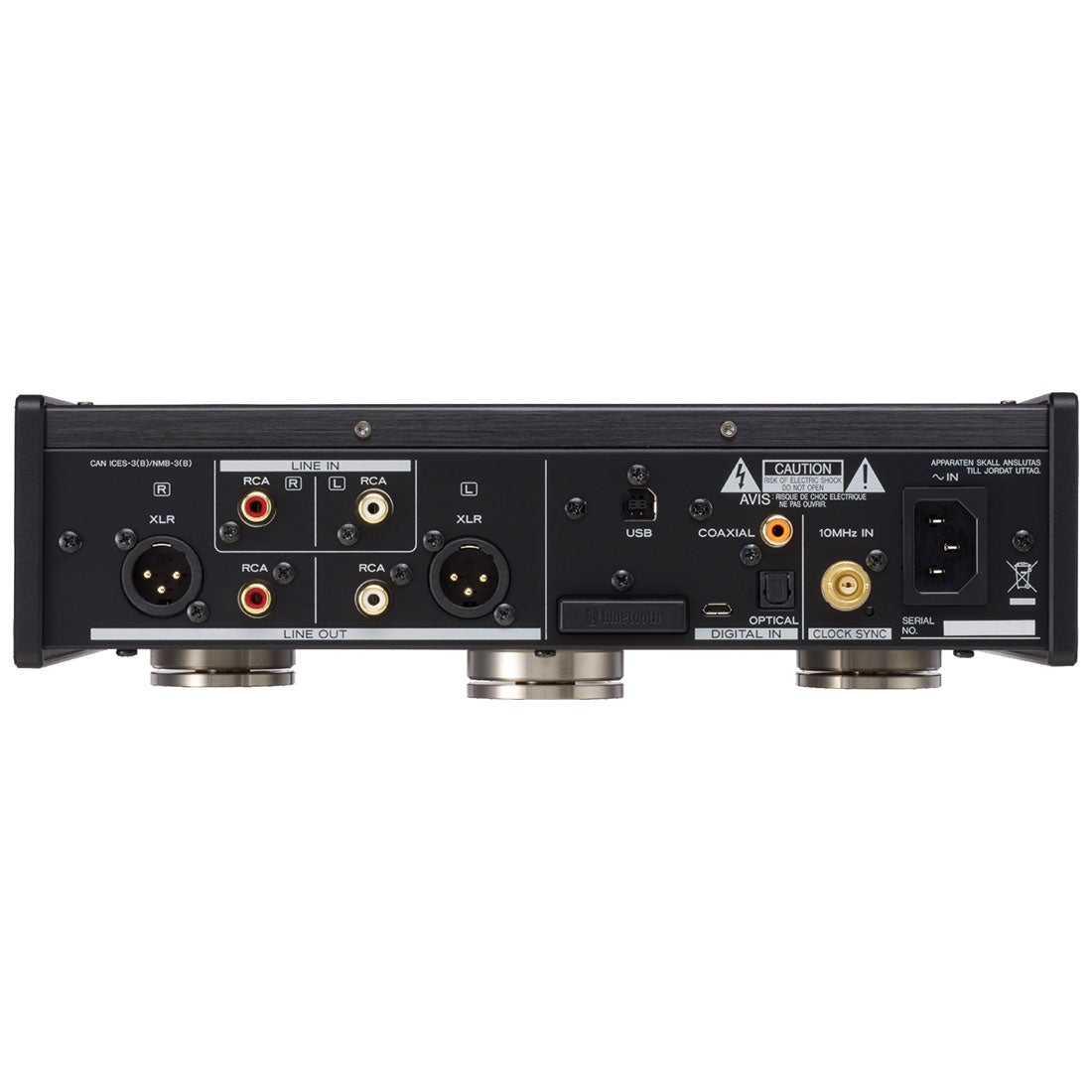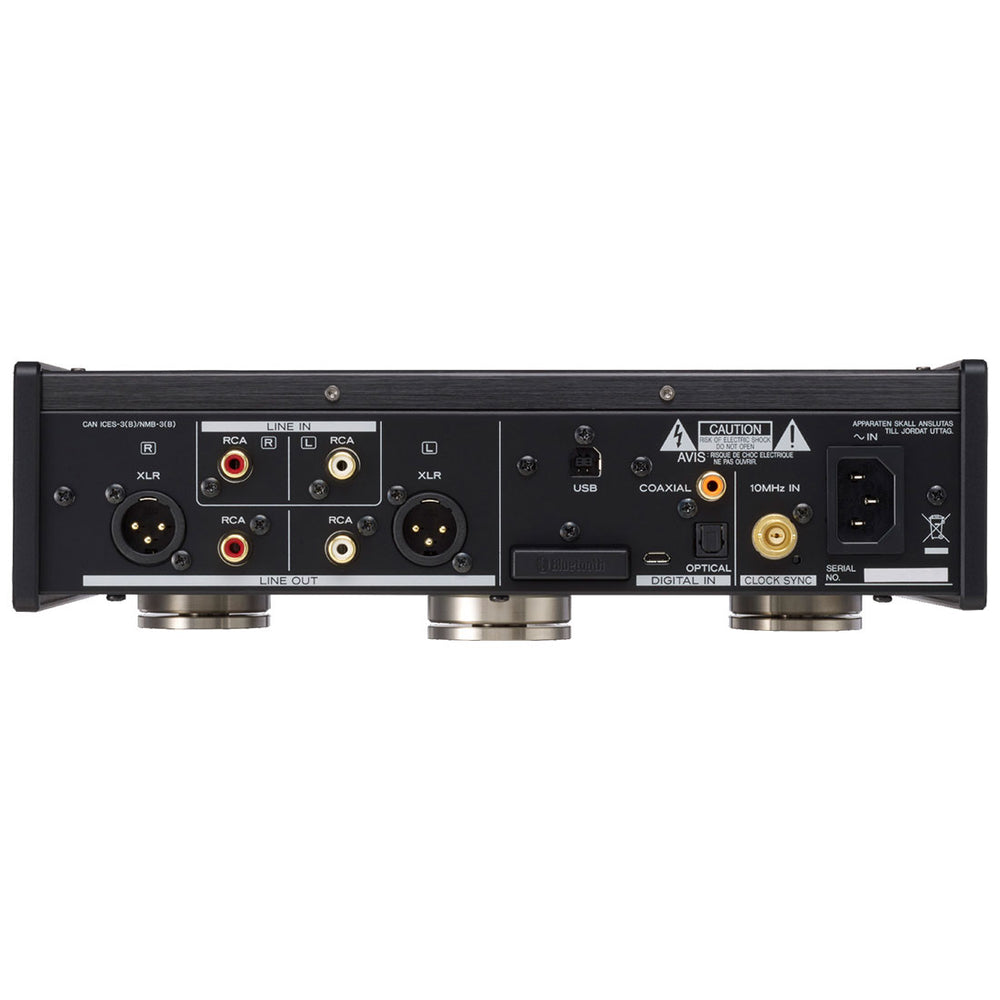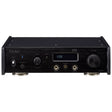
Payment as low as
This monthly payment does not include any applicable tax or interest
Covers shipping up to 7% of product value. If costs exceed this, we'll quote before shipping or cancel and refund.
Free Shipping |
We guarantee the best price in Canada—before or 30 days after purchase.*
Lowest Price Guarantee*
This product is backorderable
Sign up to get notified when it's in stock!
Product Description
Product Description
TEAC UD505XB Reference 500 Series USB DAC / Headphone Amp / Preamp - Black
A dual-monaural USB DAC/headphone amplifier that supports PCM32/768 and DSD512
The flagship UD505XB dual monaural USB DAC from TEAC combines high-end audio design principles with decades of audio design expertise in an A4-sized footprint. It also has an inbuilt fully-balanced headphone amplifier.
High-performance VERITA AK4497 DACs that support PCM32/768 and DSD512
Asahi Kasei Microdevices' most recent VERITA AK4497 is used by the UD505XB on both the left and right channels. It is a well-known high-end audio DAC that supports the formats DSD512 (22.5MHz) and 768kHz/32-bit PCM while reaching the lowest distortion levels possible. In contrast, out-of-band noise is greatly diminished by OSRD (Oversampling Ratio Doubler) technology. Because of this, the UD505XB has the finesse required to maximise Hi-Res formats and successfully handle data that is outside the audible range.
* The AK4497 is the star product of the Asahi Kasei Microdevices Audio4proTM family which was created for high-end digital audio and professional audio equipment.
Bluetooth®-Based High-Resolution Wireless Audio Streaming
LDACTM (24/96 Hi-Res audio transmission) and Qualcomm® aptXTM HD, a codec that uses a 24/48 format transmission are two additional codecs that the UD505XB supports in addition to the traditional SBC and AAC codecs. On your tablet and smartphone, you can wirelessly stream playlists courtesy to these.
Fully Balanced And Dual Monaural Circuit Designs
From the power supply (including power transformers), to the D/A converters in the digital portion and the analogue output stage, a dual monaural circuit architecture is used throughout. Each component, from the robust toroidal-core power transformers to the high-performance VERITA AK4497 D/A converters, is set up for single channel processing. This replicates a rich sonic expressiveness while preventing mutual interference effects. Additionally, the left and right channels' analogue audio signals are both treated in full balanced mode shortly after the D/A converters until they reach the output terminal which contributes to a higher S/N ratio and a wider dynamic range. This enables Hi-Res formats amazing sense of atmosphere to be processed and transmitted without suffering any loss.
44.1kHz And 48kHz Dual On-Board Clocks As Well As An External Clock Input
For USB asynchronous transmission mode, a high-precision, low phase-noise, audio-grade crystal oscillator generates a more reliable and on-board clock instead of referring to an erratic and noisy PC clock during USB audio playback. The UD505XB has two on-board clocks that are only compatible with sampling rates of 44.1 kHz and 48 kHz and it applies the appropriate one to incoming digital signals that are multiples of 4 kHz or 48 kHz in order to replicate the original audio without jitter. For even better audio playing with superb sound quality, an external 10MHz clock input is also offered. This allows you to synchronise with a master clock generator with even higher precision such as the TEAC CG-10M.
Up-Conversion Up To 384kHz/32-bit PCM and 24.5MHz DSD
The UD505XB up-converts PCM digital signals up to 384kHz/32-bit PCM and 24.5MHz DSD by using RDOT-NEO, a fluency algorithm that renders digital audio signals smoothly. Even with music you are accustomed to, the quality will improve when the up-conversion function is turned on.
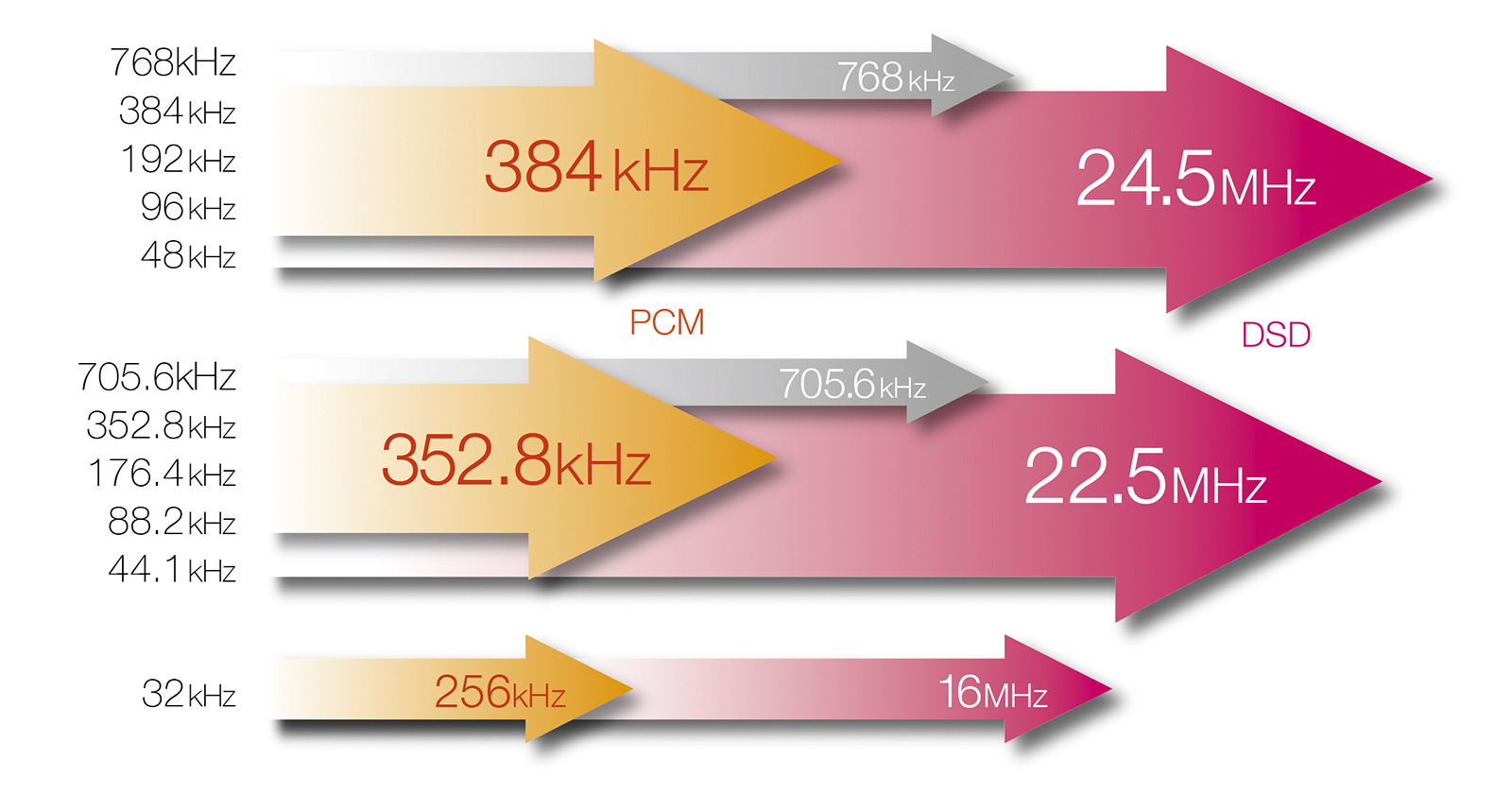
"Bulk Pet" USB Transfer Technology For Enhanced Audio Quality
The processing demands of the sending computer and the receiving USB DAC might vary greatly when moving significant amounts of digital data for Hi-Res audio sources over USB connections in the traditional isochronous transmission mode. This may result in sound interruptions and other issues but with our brand-new "Bulk Pet" USB transmission technology in the UD505XB, a defined amount of data is sent continuously, balancing the load on both devices and promoting steady data transmission. Users can choose their preferred option by altering the processing load on the computer which directly influences audio quality (from four transmission modes).

Interface Corporation is the registered proprietor of the trademark "Bulk Pet." *Please visit the Interface Corporation website to learn more about "Bulk Pet."
Added Digital Filters Compared To The Prior Model
You can select the filter that best suits the file format or style of music you're listening to on the UD505XB, which has two types of DSD filters and an additional five types of PCM digital filters. You may enjoy the various audio characteristics of each filter by switching the filter at the touch of a button on the remote control.
Separate Parts For Digital And Analogue
The UD505XB uses an isolated power supply and ground circuit to suppress interference between the digital and analogue portions, eradicating cross-interference in the signal channel where the digital and analogue sections link. At the input portion, a digital isolator is used to filter out noise from any connected digital sources, including noise produced by the computer through USB, the power line, and the ground path. The signal-to-noise ratio and overall sound quality are both significantly enhanced by this isolation circuit.
Power Transformers With Two Toroidal Cores And Huge Capacities
The dual monaural motif is still present. The UD505XB uses two large, high-capacity toroidal-core power transformers to provide stable, separate current sources for the left and right channels. This means that changes in one channel's power usage during digital processing won't have an impact on the other. 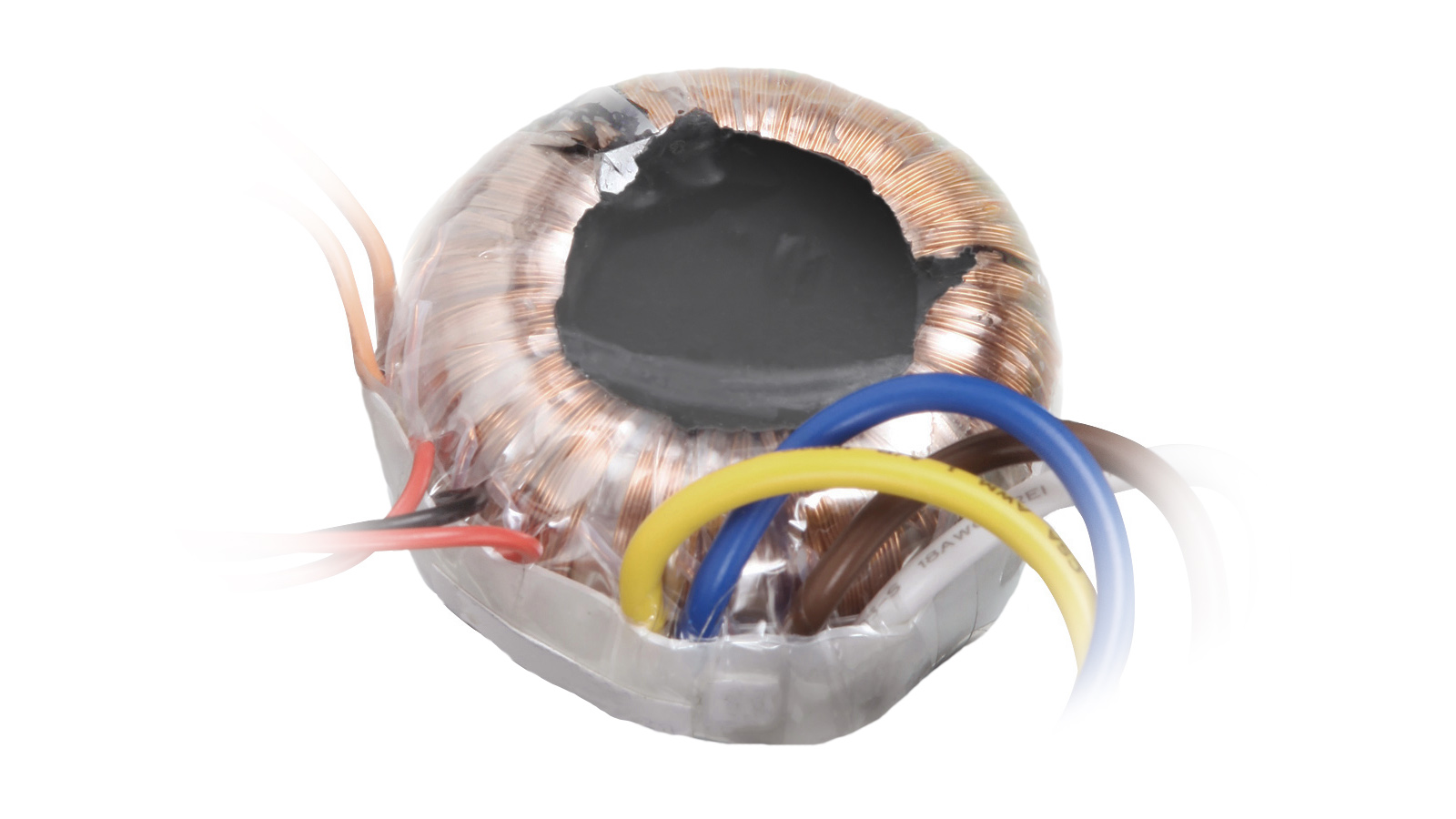
Specialised TEAC-HCLD Output Buffer Amp Circuits
The TEAC-HCLD (High Current Line Driver) buffer amp circuits which are intended to improve current supply, are at the centre of the analogue portion. To handle differential drive for balanced output and parallel drive for unbalanced output, each channel has two identical buffer amps. The analogue audio signal is transmitted to the following step without any loss of dynamism by increasing the current supply to the buffer amp section. 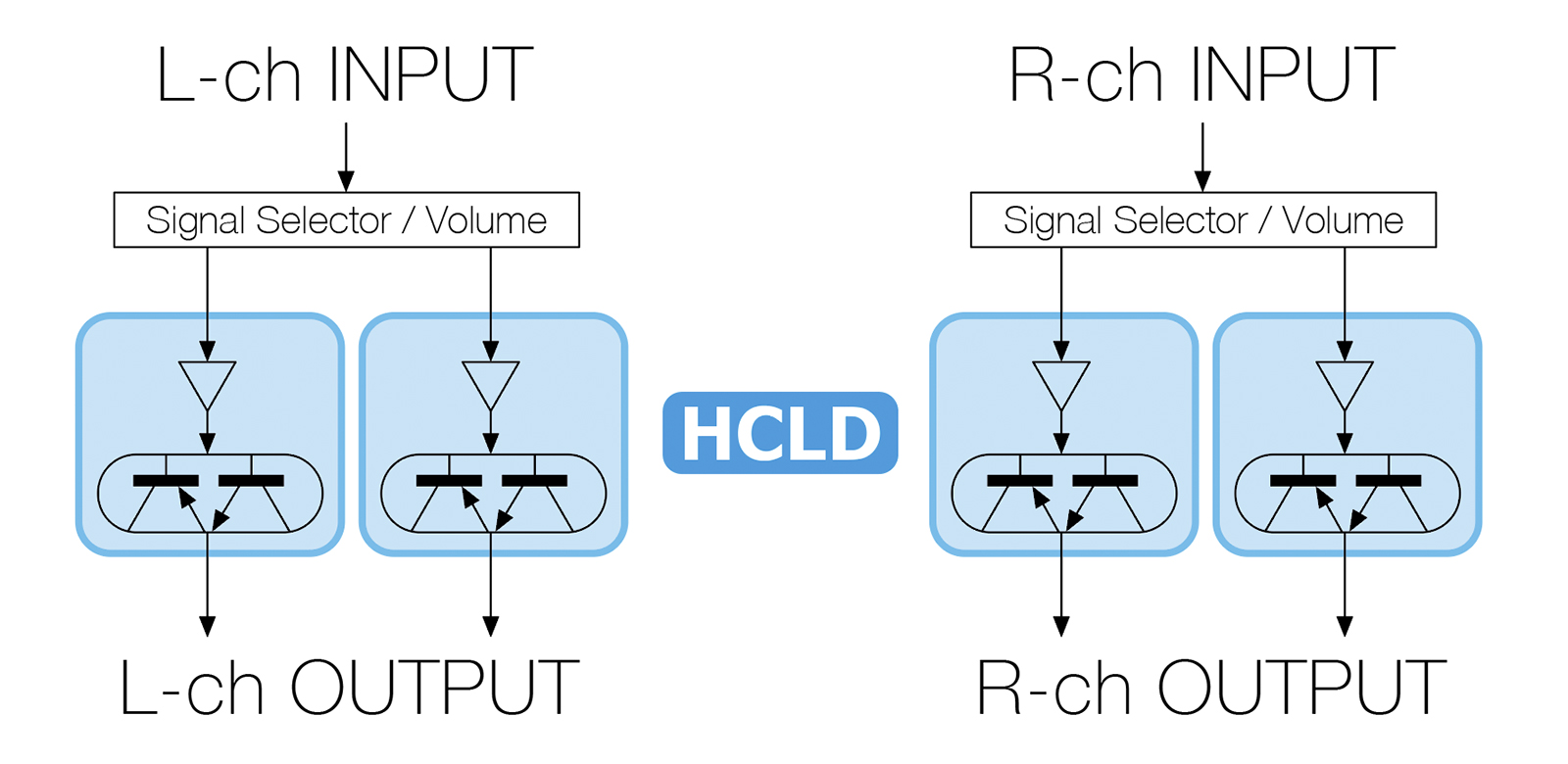
TEAC-QVCS Four-Circuit High-Precision Volume Control
XLR (balanced) and RCA (unbalanced) outputs with fixed/variable levels, a variety of Analog/digital inputs and processing performance. These enable you to create either a complex system centered on a pair of active speakers or a stereo amplifier/pair of monaural power amplifiers around the UD505XB. The pre-amp portion includes a precise volume control design called the TEAC-QVCS (Quad Volume Control System). This circuit uses four sets of variable gain amplifiers (L+, L-, R+, R-) to regulate volume for the left, right, positive and negative channels. Each variable gain-amp is situated on a streamlined signal path that shortens the signal path, reducing interference noise. Additionally, the TEAC-QVCS offers accurate volume control in 100 steps or 0.5dB steps in "step" display mode.
Balanced Drive And Discrete Circuit Design
The UD505XB's headphone amplifier circuit uses the TEAC-HCLD circuit, which has four output transistors for each left and right channel to provide balanced-drive for headphones. The UD505XB provides higher driving power than most common single-ended headphone amps by running these transistors in parallel when a single-ended headphone is connected. Despite having a Class-A/B amplifier, it also runs in Class-A when using standard headphones (by widening the Class-A spectrum of operation). The UD505XB enables you to maximize the capabilities of headphones of this type, such as difficult 600 high-impedance headphones.
A Novel Headphone Driving Mode Is Provided Via Active-Ground Drive
A brand-new driving mode that makes use of balanced connection theory is called active-ground. Instead of just connecting to the standard ground, it forces the ground to be at 0V, creating the perfect ground condition. By decreasing the noise floor, it also suppresses power supply hum noise and improves the purity of silent pauses. Simple details like the artists' breathing and the sounds' textures will seem significantly more convincing. 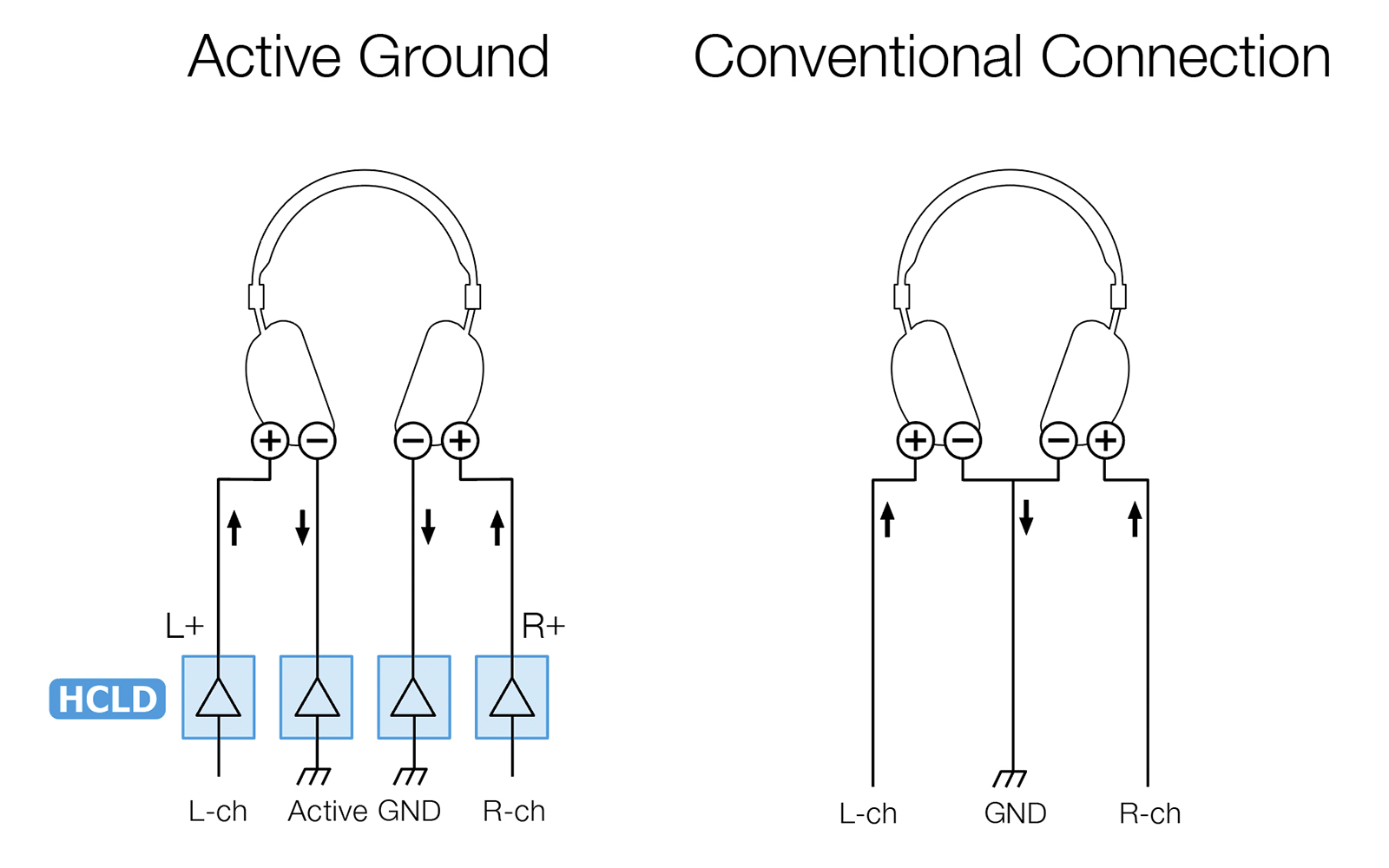
The Brand-New Pentaconn Single-Plug connector For Balanced Headphone Drive
The UD505XB uses a newly created single headphone jack for balanced drive in addition to the dual traditional 1/4" TRS jacks for balanced connection. The 4.4mm Pentaconn jack, created by NIPPON DICS Co., Ltd., complies with the RC-8141C JEITA Standard and offers a single-jack option for balanced headphones. In the near future, more headphones and cables with Pentaconn jacks are expected.
Full-Metal Body For Aesthetics And Functionality
The UD505XB uses aluminum-alloy panels, including trademark side guard-bars, and a sturdy metal chassis with a small A4-size footprint* that is totally compatible with the 500 series and the new CG-10M master clock generator, just like the popular Reference 503 series. The whole metal construction is not only stunning, but also useful. It is very good at shielding the internal circuits from electromagnetic interference.
* Excluding knobs, connections, and other protruding components.
XLR And RCA Output Jacks That Are Symmetrically Arranged
Both balanced and unbalanced Analog audio outputs are available on the UD505XB. There are two pairs of gold-plated XLR connectors and two pairs of RCA connectors symmetrically arranged on the device, hinting at the dual monaural setup within and enabling a variety of audio configurations. Professional quality plugs with large-diameter shells can fit on the RCA outputs thanks to a layout with a wide spacing between the pins. Five digital inputs are available on the UD505XB: USB audio, coaxial, optical on the rear panel, and a combination connection (for coaxial and optical, supporting PCM 24/192 and DSD64 in DoP format) on the front panel. The UD505XB can act as a pre-amplifier equipped with a high-quality and precise volume control by using a pair of RCA analogue audio input connectors (TEAC-QVCS).
"Pin-Point" Feet With Three Positions And A Patent For Maximum Stability
The "Pin-Point" feet on the UD505XB are TEAC's patented design. These cleverly combine two independent metal pieces in a single housing. One is fastened to the chassis's bottom and has a spiked top, while the other is installed more easily and has a basin-shaped base that hangs down from the spiked section. For outstanding stability, even on an uneven floor, three "Pin-Point" feet are employed. Two at the front and one at the back. The three "Pin-Point" feet reduce vibrations and resonance, which helps increase the accuracy of clock oscillation. In turn, this lessens mid- and low-frequency muddiness, boosts fine sound detail, and improves the soundstage.
* Patent numbers 4075477 and 3778108
Free TEAC HR Audio Player Software Is Available For Both Windows And Mac To Playback DSD512
The TEAC HR Audio Player software for Windows and Mac supports DSD512 (22.5MHz) and PCM 768kHz/32-bit, the next-generation Hi-Res formats. With every combination of audio format and computer setup, this software ensures the highest playback quality possible over a single USB cable. Simply selecting the UD505XB from the pull-down menu of target output devices is all that is required of the user. The TEAC HR Audio Player can be downloaded for free from the company's website.
* A free driver, also offered by TEAC, is required for use on a Windows PC.
Free TEAC HR Audio Player Software Is Available For Both Windows And Mac To Playback DSD512
The TEAC HR Audio Player software for Windows and Mac supports DSD512 (22.5MHz) and PCM 768kHz/32-bit, the next-generation Hi-Res formats. With every combination of audio format and computer setup, this software ensures the highest playback quality possible over a single USB cable. Simply selecting the UD505XB from the pull-down menu of target output devices is all that is required of the user. The TEAC HR Audio Player can be downloaded for free from TEAC's website.
* A free driver, also offered by TEAC, is needed for use on a Windows PC.


